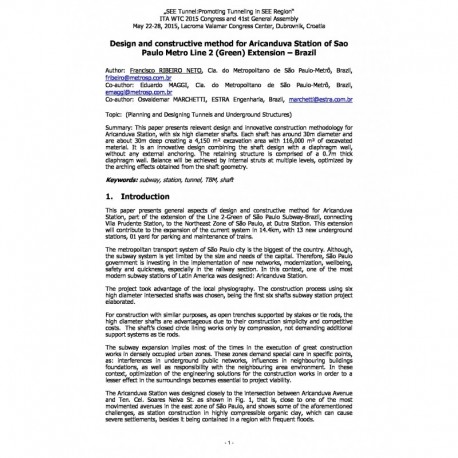Cart
0
0
No document
0,00 €
Total
Document successfully added to your shopping cart
Quantity
Total
There are 0 items in your cart.
There is 1 item in your cart.
Total documents
Total shipping
To be determined
Total
Search & filter
Search for a publication
Search & filter
Design and constructive method for Aricanduva Station of Sao Paulo Metro Line 2 (Green) Extension – Brazil
wtc2015_full_ribeironeto-1
O. Marchetti / F. Ribeiro Neto / E. Maggi
This paper presents general aspects of design and constructive method for Aricanduva Station, part of the extension of the Line 2-Green of São Paulo Subway-Brazil, connecting Vila Prudente Station, to the Northeast Zone of São Paulo, at Dutra Station. This extension will contribute to the expansion of the current system in 14.4km, with 13 new underground stations, 01 yard for parking and maintenance of trains. The metropolitan transport system of São Paulo city is the biggest of the country. Although, the subway system is yet limited by the size and needs of the capital. Therefore, São Paulo government is investing in the implementation of new networks, modernization, wellbeing, safety and quickness, especially in the railway section. In this context, one of the most modern subway stations of Latin America was designed: Aricanduva Station. The project took advantage of the local physiography. The construction process using six high diameter intersected shafts was chosen, being the first six shafts subway station project elaborated. For construction with similar purposes, as open trenches supported by stakes or tie rods, the high diameter shafts are advantageous due to their construction simplicity and competitive costs. The shaft’s closed circle lining works only by compression, not demanding additional support systems as tie rods.The subway expansion implies most of the times in the execution of great construction works in densely occupied urban zones. These zones demand special care in specific points, as: interferences in underground public networks, influences in neighbouring buildings foundations, as well as responsibility with the neighbouring area environment. In these context, optimization of the engineering solutions for the construction works in order to a lesser effect in the surroundings becomes essential to project viability. The Aricanduva Station was designed closely to the intersection between Aricanduva Avenue and Ten. Cel. Soares Neiva St. as shown in Fig. 1, that is, close to one of the most movimented avenues in the east zone of São Paulo, and shows some of the aforementioned challenges, as station construction in highly compressible organic clay, which can cause severe settlements, besides it being contained in a region with frequent floods.




